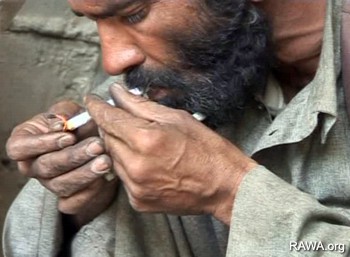Colum Lynch
Afghan opium poppy cultivation grew 17 percent last year, continuing a six-year expansion of the country's drug trade and increasing its share of global opium production to more than 92 percent, according to the 2008 World Drug Report, released Thursday by the United Nations.

The opium trade has soared since the U.S.-led 2001 overthrow of the Taliban, which had eradicated almost all of the country's opium poppies.
Afghanistan's emergence as the world's largest supplier of opium and heroin represents a serious setback to U.S. policy in the region. The opium trade has soared since the U.S.-led 2001 overthrow of the Taliban, which had eradicated almost all of the country's opium poppies. The proceeds from the illicit trade are helping finance a resurgent Taliban that is battling U.S. and allied troops.
The Taliban earned $200 million to $400 million last year through a 10 percent tax on poppy growers and drug traffickers in areas under its control, Antonio Maria Costa, executive director of the U.N. Office of Drugs and Crime, said in an interview. He estimates that Afghan poppy farmers and drug traffickers last year earned about $4 billion, half of the country's national income.
Afghanistan's high-yielding variety of opium poppies has helped double global opium production since 2005. With production far outpacing world demand, U.N. anti-drug officials and government intelligence agencies worry about massive stockpiling of the drug. "There will be two or three thousand tons of extra supply this year," Costa said.
The Bush administration cited U.N. data suggesting that opium production will fall slightly this year in Afghanistan but acknowledged the scope of the problem. "The drug threat in Afghanistan remains unacceptably high and requires a long-term commitment by both the Afghan government and international donors," said Susan Pittman, spokeswoman for the State Department's Bureau of International Narcotics and Law Enforcement.
However, the administration also said the U.N. report confirms its view that international efforts to contain the use of illicit drugs are succeeding, including in the United States, where drug consumption has dropped over the past decade.
The 309-page report tracks a surge in marijuana production in Afghanistan and an increase in cocaine production in Bolivia, Peru and Colombia. The United Nations noted new hubs for transshipment and drug use -- including Saudi Arabia, which in 2006 led the world in seizures of amphetamines.
Some 26 million people worldwide are addicted to drugs, the report said, and about 5 percent had used an illicit drug in the 12 months preceding the study. Illicit drugs account for about 200,000 deaths per year, a small fraction of the nearly 5 million annual deaths from tobacco.
Drug consumption in the United States, meanwhile, continued a "very significant" reduction, Costa said. Among the findings was a 19 percent drop over the past decade in the number of U.S. workers who tested positive for cocaine use.
"The U.S. has always been characterized by very high levels of drug addiction," Costa said. But in the past five years, "we have noted a perceptible decrease, especially among the younger population, aged 16 to 22," he said. "The country is doing something right."



